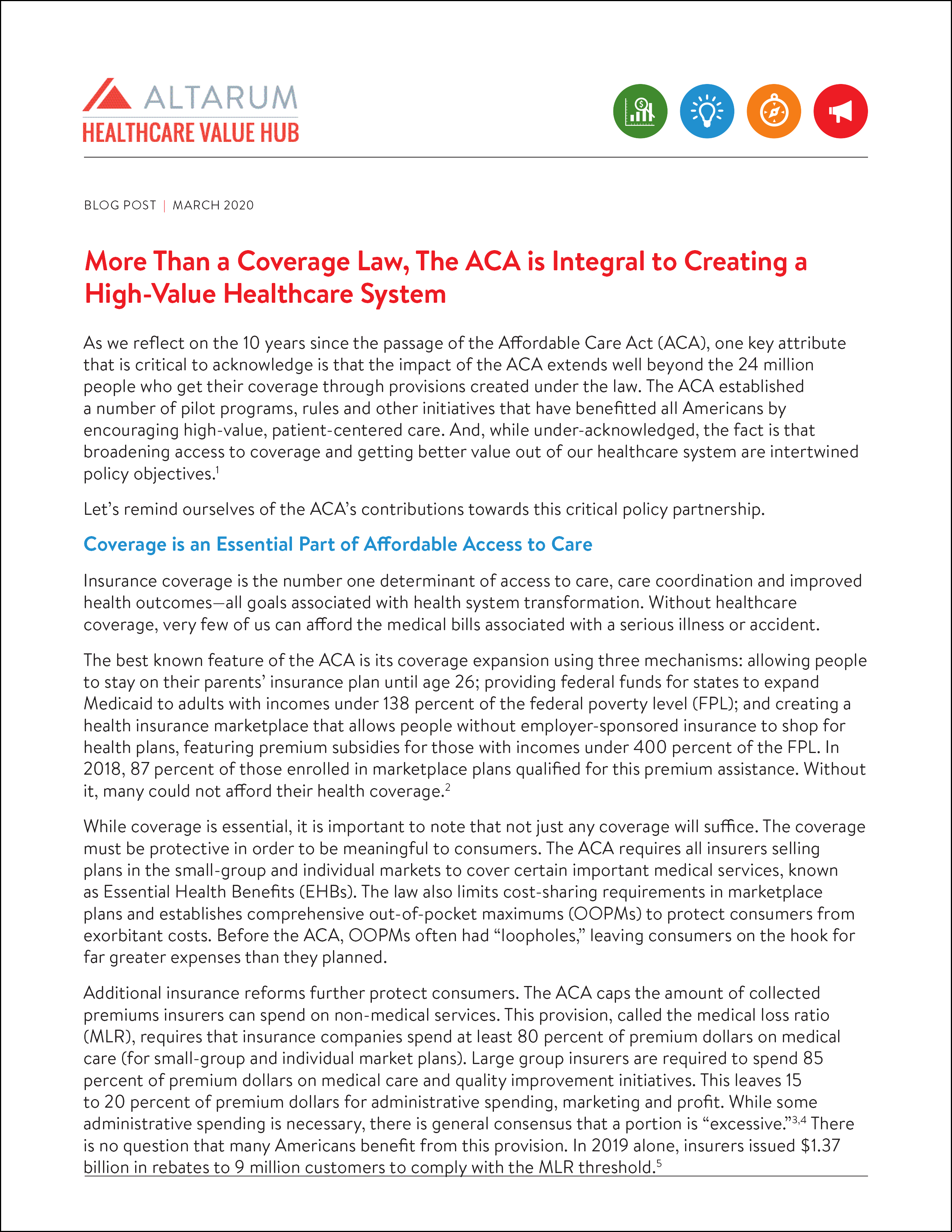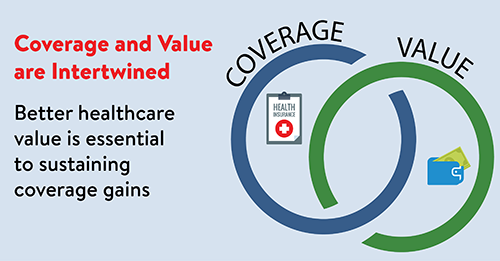More Than a Coverage Law, the ACA is Integral to Creating a High-Value Healthcare System
By Sabah Bhatnagar, Policy Analyst
As we reflect on the 10 years since the passage of the Affordable Care Act (ACA), one key attribute that is critical to acknowledge is that the impact of the ACA extends well beyond the 24 million people who get their coverage through provisions created under the law. The ACA established a number of pilot programs, rules and other initiatives that have benefitted all Americans by encouraging high-value, patient-centered care. And, while under-acknowledged, the fact is that broadening access to coverage and getting better value out of our healthcare system are intertwined policy objectives.1
Let’s remind ourselves of the ACA’s contributions towards this critical policy partnership.
Coverage is an Essential Part of Affordable Access to Care
Insurance coverage is the number one determinant of access to care, care coordination and improved health outcomes—all goals associated with health system transformation. Without healthcare coverage, very few of us can afford the medical bills associated with a serious illness or accident.
The best known feature of the ACA is its coverage expansion using three mechanisms: allowing people to stay on their parents’ insurance plan until age 26; providing federal funds for states to expand Medicaid to adults with incomes under 138 percent of the federal poverty level (FPL); and creating a health insurance marketplace that allows people without employer-sponsored insurance to shop for health plans, featuring premium subsidies for those with incomes under 400 percent of the FPL. In 2018, 87 percent of those enrolled in marketplace plans qualified for this premium assistance. Without it, many could not afford their health coverage.2
While coverage is essential, it is important to note that not just any coverage will suffice. The coverage must be protective in order to be meaningful to consumers. The ACA requires all insurers selling plans in the small-group and individual markets to cover certain important medical services, known as Essential Health Benefits (EHBs). The law also limits cost-sharing requirements in marketplace plans and establishes comprehensive out-of-pocket maximums (OOPMs) to protect consumers from exorbitant costs. Before the ACA, OOPMs often had “loopholes,” leaving consumers on the hook for far greater expenses than they planned.
Additional insurance reforms further protect consumers. The ACA caps the amount of collected premiums insurers can spend on non-medical services. This provision, called the medical loss ratio (MLR), requires that insurance companies spend at least 80 percent of premium dollars on medical care (for small-group and individual market plans). Large group insurers are required to spend 85 percent of premium dollars on medical care and quality improvement initiatives. This leaves 15 to 20 percent of premium dollars for administrative spending, marketing and profit. While some administrative spending is necessary, there is general consensus that a portion is “excessive.”3,4 There is no question that many Americans benefit from this provision. In 2019 alone, insurers issued $1.37 billion in rebates to 9 million customers to comply with the MLR threshold.5
Wise Use of Services and Fair Prices make it Easier to ‘Afford’ Universal Coverage
It is well documented that much of U.S. healthcare spending is wasted on unnecessary services, that we underspend on important preventive care and that, in many markets, providers and pharmaceutical manufacturers charge excessive rates. A 2019 report estimated 25 percent of U.S. healthcare spending is “wasteful” and does not support better health.6
The ACA recognized that reducing unnecessary spending and better aligning expenditures with people’s health needs would increase efficiency and lower the cost of covering them. The law created numerous pilots, rules and other initiatives that have supported a transition to high-value, patient-centered healthcare system.
The ACA created the Patient-Centered Outcomes Research Institute (PCORI) to address large gaps in our understanding of alternative treatments’ effectiveness through comparative effectiveness research.7 Given that a large percentage of the medical care patients receive is not evidence-based, this research helps decision-makers understand which treatments are effective for different types of patients and allows payers to increase spending on effective treatments and decrease spending on less effective treatments.
In the prescription drug arena, the ACA created a ‘generic’ pathway for expensive biologic medicines. As a result, the FDA has approved 23 biosimilars since 2016.8 Prior to the Biologics Price Competition and Innovation Act provisions included in the ACA, there were no biosimilar competitors for biologic medicines on the market in the U.S. Experts hope the availability of biosimilars will drive down prices, as was observed with the introduction of generics for “small molecule” drugs.9
A lack of coordination between healthcare and social service entities, as well as mismatched provider incentives, are weaknesses that compromise our healthcare system. Delivery system reform and quality improvement are key imperatives of the ACA intended to rein in the rising healthcare costs while improving outcomes. These ACA provisions include: (1) reducing payments to hospitals that fail to limit preventable readmissions and (2) encouraging the use of alternative payment and delivery models like patient-centered medical homes and accountable care organizations, as well as creating the Center for Medicare and Medicaid Innovation (CMMI) to provide grants to test these models. By 2018, CMMI had launched 40 new payment models across 200,000 healthcare providers. The Congressional Budget Office projects that CMMI will save the federal government a net $34 billion between 2017 and 2026.10
Health System Transformation Depends on a Population with Coverage
Momentum for health system transformation was already underway before the passage of the ACA and continues today. Across the country, payers are exploring new ways of paying providers, new approaches to benefit design and effective ways to address social determinants of health. What is under-appreciated is the fact that these efforts rely on a population with coverage. Broad enrollment in coverage is essential to the health system transformation goals of the country, hence, the ACA has facilitated transformation both directly through its pilots and transformation-friendly regulations, but also by fundamentally changing the larger paradigm in which we debate polices. Today, the discussion is “how” we will cover everybody in an affordable manner and without penalizing those with pre-existing conditions, not “if” we will do so. Greater enrollment in coverage and improved ability to coordinate across payers are integral to transforming our health system.
The ACA: More Than a Coverage Law
What does all of this mean? The ACA is much more than a coverage law—it is integral for creating a high-value healthcare system that is affordable, equitable and produces uniformly good outcomes, ultimately benefitting all U.S. residents. Given the link between coverage and the creation of value in our health system, it benefits us to broaden our understanding of what was included in the ACA and continue to guard against an outright repeal that could have grave repercussions for not only our economy, but us and our families.
This Blog Post was written by Sabah Bhatnagar, a Health Policy Analyst for the Healthcare Value Hub.
Notes
1. Altarum’s Healthcare Value Hub, Healthcare Coverage and Value are Intertwined, Washington D.C., https://healthcarevaluehub.org/improving-value/browse-strategy/healthcare-coverage-and-value-are-intertwined (accessed March 6, 2020).
2. Collins, Sara, and Munira Z. Gunja, Premium Tax Credits Are the Individual Market’s Stabilizing Force, The Commonwealth Fund, Washington, D.C. (Aug. 15, 2018). https://www.commonwealthfund.org/blog/2018/premium-tax-credits-are-individual-markets-stabilizing-force
3. Altarum's Healthcare Value Hub, Addressing Rising Health Care Costs: A Resource Guide for Consumer Advocates, Washington, D.C. (November 2013). https://healthcarevaluehub.org/application/files/8415/6380/5477/2013ConferenceResourceGuide.pdf
4. Before the ACA, as much as 50 percent of the premiums collected were devoted to insurers’ non-medical spending. In fact, we see similar practices in the short-term, limited duration health plans that are not subject to the ACA’s MLR requirement today.
5. Lee, Chris, Private Insurers Are Expected to Pay a Record of At least $1.3 Billion in Rebates to Consumers Beginning in September for Excessive Premiums Relative to Health Care Expenses, Kaiser Family Foundation, Washington, D.C. (Sept. 10, 2019). https://www.kff.org/private-insurance/press-release/private-insurers-are-expected-to-pay-a-record-of-at-least-1-3-billion-in-rebates-to-consumers-beginning-in-september-for-excessive-premiums-relative-to-health-care-expenses/
6. Shrank, William H., et al. "Waste in the US Health Care System: Estimated Costs and Potential for Savings," JAMA Vol. 322, No. 15 (October 7, 2019). https://jamanetwork.com/journals/jama/article-abstract/2752664
7. Altarum’s Healthcare Value Hub, Comparative Effectiveness Research, Washington D.C., https://healthcarevaluehub.org/improving-value/browse-strategy/comparative-effectiveness-research (accessed March 6, 2020).
8. U.S. Food and Drug Administration, Biosimilar Product Information, https://www.fda.gov/drugs/biosimilars/biosimilar-product-information (accessed on Oct. 15, 2019).
9. Small molecule (non-biologic) drugs are typically composed of only 20 to 100 atoms. In contrast, small biologics, such as hormones, are typically composed of 200 to 3000 atoms, while large biologics, such as antibodies, are typically composed of 5000 to 50,000 atoms. Evidence examining the first category suggests that multiple generic competitors can lower the average generic price to 20 percent of the price of the brand name product.
10. Kaiser Family Foundation, “What is CMMI?” and 11 other FAQs about the CMS Innovation Center, Kaiser Family Foundation, Washington D.C. (Feb. 27, 2018). https://www.kff.org/medicare/fact-sheet/what-is-cmmi-and-11-other-faqs-about-the-cms-innovation-center/








